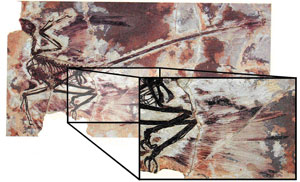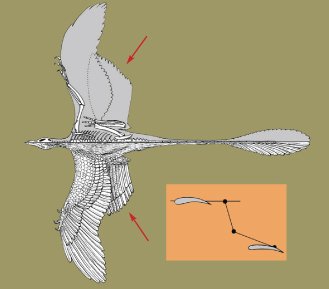An Ancient Feathered Biplane
A dinosaur may have glided from tree to tree on two sets of wings, one below the other.
Share this:
- Share via email (Opens in new window) Email
- Click to share on Facebook (Opens in new window) Facebook
- Click to share on X (Opens in new window) X
- Click to share on Pinterest (Opens in new window) Pinterest
- Click to share on Reddit (Opens in new window) Reddit
- Share to Google Classroom (Opens in new window) Google Classroom
- Click to print (Opens in new window) Print
By Emily Sohn
When the Wright Brothers lifted off at Kitty Hawk in 1903, they flew a plane with two sets of wings, one below the other. Their feat went down in history as the first successful flight by a heavier-than-air aircraft.
New evidence suggests that dinosaurs may have beaten the Wright Brothers to the punch in coming up with a biplane design.
 |
|
A fossil of a gliding dinosaur known as Microraptor gui. The inset is an enlarged view of the animal’s leg feathers.
|
| PNAS |
Four years ago, paleontologists described a species of dinosaur from China called Microraptor gui. These dinos were about 3 feet long and feathered. They even had feathers on their legs and feet.
The leg feathers puzzled scientists. Some researchers proposed that the dinosaurs opened their legs into a split when they flew, creating a second set of wings behind the first. None of M. gui‘s closest relatives, however, had hips that were flexible enough to stretch out that far.
Now, two scientists have a new theory of how these creatures glided. Their model proposes that M. gui dangled its legs underneath its body while in the air. This would have created two sets of wings, one below and slightly behind the other. Biplanes that do aerobatic stunts have a similar design.
 |
|
This drawing shows what the dinosaur might have looked like. The second set of wings (arrows in main image) created when this dinosaur dangled its feathered legs and feet below its body would have provided flight surfaces like those of a modern biplane. The inset shows the positions of the dinosaur’s two sets of wings, as seen from the side.
|
| PNAS |
The 19-centimeter-long feathers near the bottom of the animal’s legs support this theory, the scientists say. Their design would have helped keep the feathers from twisting as the dinosaur generated lift.
Based on this model, the scientists say that M. gui probably could not have survived a vertical fall from a tall tree. However, computer flight simulations show that, if the animal took a strong horizontal leap from a branch, its biplane wings could have carried it to other trees at least 40 meters (130 feet) away.
The technique would have made M. gui efficient in the air, but the dinosaurs were probably not very graceful on land. They did not have strong chest muscles, suggesting that they could not take off from the ground. And with such long leg feathers, the animals probably would have tripped all over themselves while walking.—E. Sohn
Going Deeper:
Perkins, Sid. 2007. Ancient glider: Dinosaur took to the air in biplane style. Science News 171(Jan. 27):53. Available at http://www.sciencenews.org/articles/20070127/fob6.asp .
Rehmeyer, J. 2006. Flying on wings and legs. Science News for Kids (Sept. 27). Available at http://www.sciencenewsforkids.org/articles/20060927/Note3.asp .
LabZone
Wing It!
http://www.sciencenewsforkids.org/articles/20050914/LZActivity.asp
Design a Paper Glider
http://www.sciencenewsforkids.org/articles/20040728/LZActivity.asp
ScienceFairZone
Angle of Attack and Lift
http://www.sciencenewsforkids.org/articles/20040505/ScienceFairZone.asp







